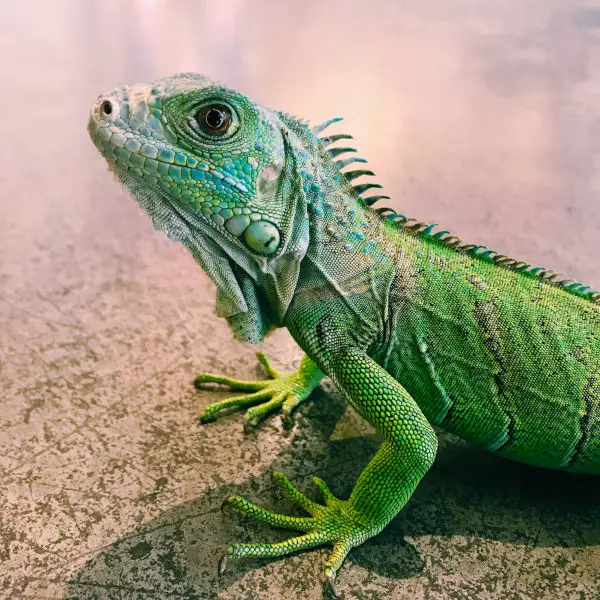Do Lizards Like Loud Music? (Can They Even Hear?)
If you have been curious or researching lizards you may have wondered if they appreciate music or if it can get too loud for them…
Do lizards like loud music?
In general, lizards do not like loud music or noises. This is because their hearing is sensitive and it may either alarm them or distress them. If the music is at a reasonable level they may be curious about it, or simply ignore it and carry on with their day.
| Are these foods dangerous for your Beardie? | |
| Avacado? Click here to learn, from this guide, if this food is dangerous |  |
| Superworms? Click here to learn, from this guide, if this food is dangerous |  |
So, now you know. But, can music make them curious? Do other loud noises scare them? Can lizards actually hear? Keep reading for these answers, and much more…
2 main reasons why lizards do not like loud music:

A man playing the saxophone with a guitar in the background.
Earlier you learned that lizards do not like loud noises for a couple of reasons. So, in this section I will explain, in more details, why this is:
01. Can cause them distress
When a lizard hears a loud noise it is likely to startle it. And, if it is in a domestic setting, for example, your lizard vivarium, it may feel that it is in danger. If you think about it from the little lizard’s perspective it can assume it is going to be eaten by a bigger predator due to its size and restraints in the tank.
This may seem far-fetched in a domestic tank, but these responses are ingrained in most lizards instincts. Known as their survival instinct.
02. Can awaken them
Also, aside from their general fear of the sound, it can awaken them. This is common sense really. It’s the same response we humans would have to loud noise, or music, while we were sleeping, right?
Can lizards be curious about music?
Lizards can be curious about music. If the music is not too loud and it suddenly comes on there have been reports from lizard owners that their lizard has ventured out of its hiding place to investigate. For example, one monitor lizard owner has reported this.
again, this makes perfect sense and really results in another survival instinct. Because the sound is not loud and threatening it is not enough to completely startle them. But, they would like to know what it is to for their curiosity, same as us human would.
Do loud noises scare lizards?
Loud noises definitely scare lizards, for example, loud weather conditions. If you had some serious lightning, for example, and your lizard was near to the window it could easily startle it. if this is the case it’s worth temporarily moving it to make it feel more secure.
Can lizards dance?
Some lizards can dance. But, strictly speaking, it’s not the same as a human dance. It is more of an interesting movement of their feet which can be used in self-defense or even funny head bobs from other lizards.
So, if you see your lizard do some interesting foot maneuvers you know this could be their version of dancing.
Can Lizards Hear?

A green Iguana lizard on the ground.
Liards can hear. They may not have ear flaps like us humans but they do have ears and eardrums, The latter is located beneath their skin and all that is visible are small openings that collect the sound waves. Although they can’t hear as well as us humans, they can hear better than other reptiles, such as snakes.
How do Lizards Hear?
You might think that due to the absence of ears, present in many animals, lizards are deaf! However, the truth is far from it!
The main source of vibrations in lizards is the tympanic membrane which catches vibrations and passes them along to the bones in the middle ear cavity and finally to the cochlear duct to transmit the information to the auditory nerve.
So, it goes without saying that many lizards can still hear while, visibly, they appear to be earless, since the tympanic membrane may be mounted on the surface or the subsurface of the ear.
However, there are quite a few variations in auditory that can be found amongst these lizards. These morphological variations usually arise due to the difference in depth of the membrane from the surface, the size of the membrane as well as the thickness.
Some lizards have surface tympanic membranes while others have recessed ones, such as in humans. However, they do not have extensive external structures like ours. Instead, they have ear openings. Although some lizards do have angled openings or scales in front of opening that function quite like the human external ear.
Do Lizards Have Ear Flaps?
The quick answer is no! You will not find any lizards with elaborate and complex ear structures found in many mammals.
They have small ear openings for catching sounds. Their tympanic membrane, or known more commonly as the eardrum, is located inside these openings.
However, some lizards do not even possess these ear openings. These lizards are mostly burrowing lizards that often need to dig deeper into the sad. The absence of ear-opening, thus, prevents any sand from entering their ears and damaging their hearing.
Even the tympanic membrane is absent in these lizards. Instead, they hear using low-frequency vibrations from the ground since they are sub-terranean.
What Is a Lizard’s Typical Hearing Range?
Most lizards can generally hear from 100-5000 Hz, however, the best level is in the range from 400 to 1500 Hz since they possess a tympanic membrane, cavity, and Eustachian tube. Most lizards have basilar papillae which serve as the auditory sensory organ.
These papillae are divided into two different regions, where one responds to frequencies below 1000 Hz while the other performs best with higher frequencies.
Most basilar papillae can hear sounds higher than 5dB.
How Do Reptiles Hear?
Most reptiles have ears and can hear to some extent. Obviously, there are differences in species, such as the Komodo dragon, which is vastly different from a Gecko. However, the common structure is a tympanic membrane present on the surface and the subsurface which catches vibrations and transmits them to the stapes.
The stapes is a singular bone present in the middle ear cavity in reptiles. The stapes then transfer these vibrations to the inner ear fluid which then send the message to the auditory nerves. A Eustachian tube connects the middle ear with the mouth.
The inner ear, in reptiles, consists of a series of hollow parts which are in an ovoidal or spherical configuration. These tubes are suspended in a fluid and are filled with a different fluid.
Most crocodiles and lizards have properly developed hearing, while turtles and snakes are not as sensitive to airborne vibrations as low-frequency earth vibrations.
Are Lizards Sensitive To Sounds?
Most lizards are incredibly sensitive to sounds. As I mentioned before, most lizards can hear sounds in the frequency range of 100-5000 Hz. Iguanas can easily hear sounds in the 500-4000 Hz range and have the ideal sensitivity at 700 Hz.
Other highly sensitive lizards such as Alligator Lizards have a wide range of high sensitivity while many others such as the Madrean Tropical Night Lizards show high sensitivity at lower frequencies in a smaller range.
Vocal Geckos can easily hear above the 10000 Hz mark and show high sensitivity. Many earless lizards such as Hoolbrookia have sensitivity limited to lower earth-borne frequencies.
Since most lizards have a smaller head, they cannot use binaural time or intensity to determine the sound direction. Mammals with much larger heads can usually detect the arrival time differences between the two ears and can guess where the sound is coming from.
With smaller heads, such as in the reptiles, the differences are much more subtle.
However, lizards can use the two tympanic membranes and couple them acoustically to produce directionality. The tympanic membrane, when exposed to sounds in the range of 1800-2400 Hz around their best-heard frequency, results in a better sense of direction.
How Big Are Lizard Ears?
Since lizards do not have external ears, the size of their ears is pretty small. It only consists of one auditory bone in the middle ear cavity while the tympanic membrane makes up most of the outer ear. The inner ear is small as well, having ovoidal and spherical tubes to carry fluids.
Due to the small heads of lizards, they have no cavity to support larger ear organs. However, some lizards do have a primitive form of external ears. These are in the form of scales in front of the ear. These may help capture vibrations and direct them further into the ear.
Related Questions:
In this section I will answer some lizard related questions that are often asked:
Do All Lizards Have Eyelids?
Most lizards possess eyelids such as most mammals do. The main function of these eyelids is to protect the eyes and clean them. These eyelids help them to blink which keeps the eyes moist and prevents desiccation.
Mostly the lower lid is movable and moves upward to close the eyes. In some lizard species, the lower lid is transparent and allows them to see with their eyes closed.
In some other species, a third eyelid called a nictitating membrane is present as well. This is usually semitransparent. It easily closes across the eyes while the eyelids are open.
In some geckos and chameleons, these eyelids have fused to become a clear membrane that protects their eyes. However, these are immobile and require constant cleaning by the animal itself.
So, the short answer is yes all lizards have eyelids, however, not all of them are mobile or can perform the same functions.
Can Geckos Blink?
While all lizards have eyelids, geckos have immobile ones. Their eyelids have fused to become an immobile transparent aperture called a spectacle. This membrane is clear and transparent and protects its eyes from dirt, dust, and sun. The pupil thus contracts and forms a series of pinholes through which the gecko sees.
The absence of an immobile eyelid makes it impossible for geckos to blink. Instead, they usually lick and clean their eyelids of any dust or debris that may have collected on them.
However, not all geckos are unable to blink! Leopard geckos are an exquisite exception to this rule. Leopard Geckos have eyelids quite like many other lizards and can easily blink. They do not have to rely upon their tongues to clean their eyelids.
Their eyelids are opaque and perform the same functions as in other animals.
How Do Lizards Smell?
It might come as a shock to you but lizards actually smell through their tongues! You might think that their nostrils would be used for smelling as in mammals. However, their nostrils serve no other purpose than to simply breathe regardless if you have a gecko, garden lizard, Red-Eyed Crocodile Skink, or any other species.
Most lizards stick their tongue out and catch the scent particles. This tongue flicking is what brings these particles to the olfactory sensory organ called the Jacobson’s organ.
As soon as the lizards catch these particles through their tongues, they quickly touch their tongue to the roof of their mouth. They then proceed to flutter their throats to help the air movement along the Jacobson’s organ allowing the particles to be moved as well.
This then allows them to sense whether there is any food nearby or whether there are enemies. Lizards use their sense of smell to find a mating partner as well.